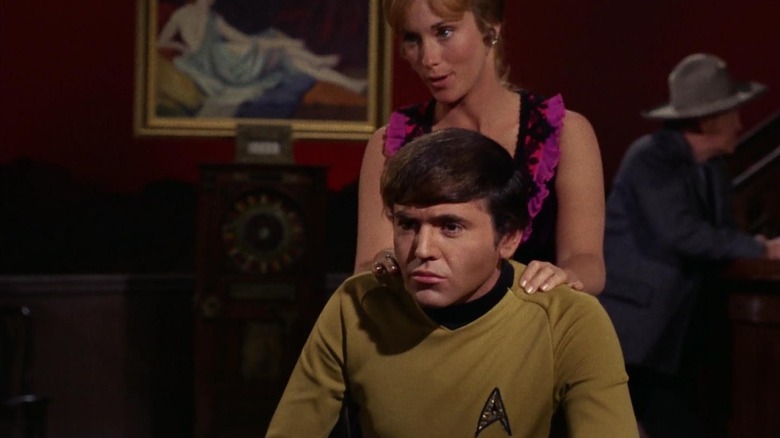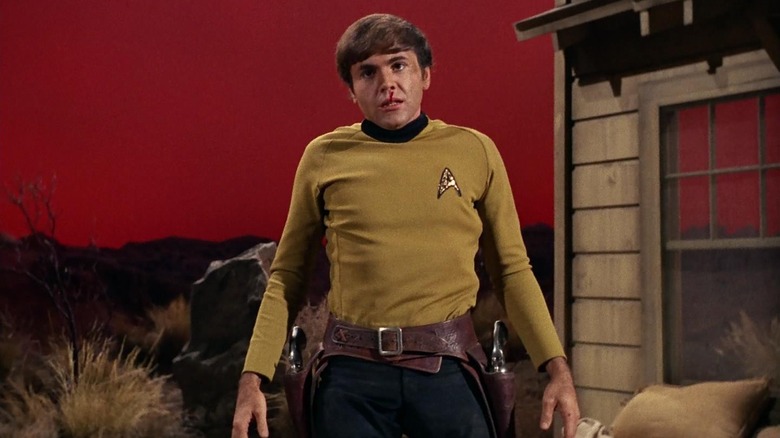Walter Koenig's Favorite Star Trek Episode Is A Low-Budget Classic
In the "Star Trek" episode "Spectre of the Gun" (October 25, 1968), the U.S.S. Enterprise is ordered to the planet Melkot to make contact with the reclusive, xenophobic species that lives there. The Melkotians are small, floating heads with powerful psychic abilities, and an unhealthy, angry suspicion of outsiders. When Kirk (William Shatner), Spock (Leonard Nimoy), Chekov (Walter Koenig), and Scotty (James Doohan) beam down to the surface, a Melkotian immediately announces that they are to be executed for their transgression of trespassing.
The Melkotian, as a means of execution, reaches into Kirk's brain and psychically creates the town of Tombstone, Arizona, circa 1881, shortly before the infamous Gunfight at the O.K. Corral. They are expected to be shot to death by psychic versions of the Earp brothers. Their phasers magically become 19th-century six-shooters, and everyone refers to them as key players in the notorious gunfight. Kirk is Ike Clanton. Chekov is Billy Claiborne. And so on. The Melkotians are using Earth's own violent history as an execution tool, proving that humans are still morally bereft.
In "Star Trek" pacifist fashion, Kirk and co. will have an opportunity to prove that humanity is now more enlightened than in 1881, and that we no longer use violence or guns to solve problems.
In an interesting design choice, the psychic version of Tombstone is abstract and theatrical. The world has uniform blood-red skies, and, curiously, none of the buildings have walls. There are free-floating doorways and window frames, but one can see straight through to the outdoors. Like Lars Von Trier's movie "Dogville," it was constructed to look like an artificial set. This, it turns out, was a budgetary choice. Director Vincent McEveety wasn't given the money to build an entire Western set, so he had to make it stylized by necessity.
It seems that the low budget made the episode more interesting to look at. Indeed, Walter Koenig was interviewed by StarTrek.com in 2011, and he noted that "Spectre of the Gun" was one of his favorites.
Walter Koenig liked the low-budget style of Spectre of the Gun
Trekkies can tell you that the original "Star Trek," during its initial run, struggled to get good ratings. NBC even gave serious consideration to canceling the series after its second season, and it was only saved by a concerted letter-writing campaign. The third season, however, had its budget slashed from $185,000 per episode in the second season to $175,000 per episode in the third. As such, several episodes relied on stripped down sets or, in some cases, blackened indoor dreamscapes that required little construction. "Spectre of the Gun," however, is an excellent example of the show using its low budget to its own aesthetic advantage.
Koenig certainly thought so. When he was asked by StarTrek.com about his favorite episodes, he noted:
"I think the one that I enjoyed doing the most and that I thought was my best episode at the time was 'Spectre of the Gun.' It was an interesting concept mandated by economics. Our budget was very small and they didn't have the wherewithal to be a complete, detailed Wild West town, so they did it in a sort of abstract manner, which I thought gave it some class and some style. I thought it was a very, very good decision and it worked very well."
Koenig also appreciated that Chekov played a sizeable role in the episode's story. He even got to have a death scene when Morgan Earp (Rex Holman) shot him in the back. Luckily, he survived; because the bullets were illusory, death was only real if the victim was convinced it was. Chekov was saved because he was thinking about a pretty lady.
Overall, though, Koenig has been pragmatic about his time on "Star Trek." He never expected it to last, and is now, many years later, just happy to have been involved. And he's right about "Spectre of the Gun." It's one of the better episodes of the third season.

